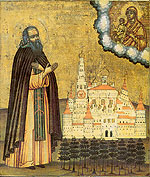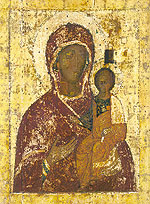 | ||
The Cathedral of the DormitionThe bell tower, whose walls were painted by Dionisy, adjoined the cathedral. It was destroyed in the 1920s  Moscow areaThe monastery is situated in Moscow area not far from the town of Volokolamsk Search | ||
 |
|
The St. Joseph Volokolamsk (Iosifo-Volokolamsky) Monastery. The Cathedral of the Dormition. After 1485
 View of the St. Joseph Volokolamsk Monastery |
The monastery was founded by St. Joseph Volotsky in 1479. St. Joseph (secular name Ivan Sanin) received the tonsure from St. Paphnutius of Borovsk whom he eventually succeeded as hegumen. He attempted to enforce a coenobitic rule which was opposed by the monastic community. He had to leave the monastery and embarked on a pilgrimage together with an elder named Gerasim. In 1479, he returned to his native Volokolamsk principality where he was granted permission by the Grand Prince of Volokolamsk Boris to establish a new cloister.
St. Joseph erected a cross on a spot which had been struck by lightning after a whirlwind, as if to show the way (this episode is described in Joseph Volotsky ‘s funeral oration by his nephew Dosifey Toporkov). Soon afterwards, a wooden church was laid in honour of the Dormition of the Mother of God. One of Joseph Volotsky’s chroniclers informs that the stone Church of the Dormition of the Mother of God was laid by Joseph on 7 June 1484 and consecrated on 18 December 1485. In 1486, for the new monastery they built a new stone cathedral whose walls were painted by Dionisy and others.
Ostensibly, Dionisy painted the Dormition Cathedral in the late 1480s. However, the murals did not survive as the cathedral was completely rebuilt in the 17th century.
During the 1480s-1490s Dionisy was repeatedly commissioned to work in the monastery. All in all he created around one hundred icons for the cloister. He worked together with his assistants and pupils. He must have been on friendly terms with the monastery’s founder Joseph Volotsky. The Epistle to the Icon Painter and three Words on Veneration of Icons, which are ascribed to Joseph, are addressed to Dionisy.
Apparently, Dionisy met Ivan Sanin in the St. Paphnutius Borovsk Monastery where Joseph took monastic vows around 1468. At exactly this time Dionisy could have painted the Holy Virgin Hodegetria icon for Joseph who took it with him to Volokolamsk to the cloister he founded in 1479.
 Joseph Volotsky |
Of numerous works made by Dionisy for the monastery only the Virgin Hodegetria survived. The inventory reports that the local icon of the Holy Virgin Hodegetria painted by Dionisy was on the Sovereign tier of the cathedral iconostasis, the first to the left of the Beautiful Gates. At present the icon is exhibited in the Andrei Rublev Museum of Early Russian Art in Moscow.
In 1479, next to the cathedral an eight-sided bell tower was built in honour of the icon of the Mother of God of Smolensk. 14 year later, in 1504, the Epiphany Church and refectory were constructed and in 1543-1566 stone walls were put up.
While the founder was alive the monastery had a very strict monastic rule that was eagerly observed by the monks. Even then the monastery was a significant centre of Old Russian culture. “No other Russian monastery displayed similar literary inspiration as did the cloister of Joseph” – Kluchevsky wrote.
Under Joseph’s successors the monastery remained the largest in Rus. In the 17th century 17 archpriests came out of it, including the godfather of Ivan the Terrible, St. Kassian the Barefooted so called because he never wore shoes, even in winter.
 The Holy Virgin Hodegetria. Dionisy |
Gury and German, future enlighteners of Kazan, were once the monastery’s hegumens. Among its patrons was Ivan the Terrible, Afanassy Nagoy, Boris Godunov and his wife Maria Grigorievna whose father Malyuta Skuratov was buried in the cloister.
Writer and translator St. Maxim Grek, non-possessor Vassian Kosoy (Prince Patrikeev), free-thinker Matthew Bashkin were incarcerated in a prison for state criminals situated in the territory of the monastery. The overthrown Vassily Shuisky was confined to the German tower at the beginning of the 17th century.
In addition, the cloister served as a fortress. The first stone walls were built in 1543-1566. During the Time of Troubles it was besieged by the Poles and for a while was occupied by an associate of False Dmitry II, prince Rozhinsky, who was defeated by voevode Valuyev’s detachment. To commemorate this event the monastery kept old cannons that shot as late as the 19th century during the water consecration ceremony.
The architectural ensemble of the cloister that reminds some researchers of a fairytale city of Kitezh, standing on a lake shore, was completed in the 17th century with the construction of a bell tower and the principal cathedral. A skillful master Stepan Polubes took part in decorating the building with tiles. The delicate carved iconostasis was made by master Evgeny Leontiev, while the painting was done by Grigory Antonov, Thomas and Vassily Potapovs.
At the beginning of the 20th century, there were five cathedrals in the cloister and a functioning skete with Joseph’s well nearby. Attached to the monastery was a guesthouse, pilgrims’ home, infirmary and parish school. The community that was managed by an archimandrite lived according to the Studite rule.
The monastery was closed down in 1922 and fell into ruin. The church vessels and objects, not taken away by the Tretyakov Gallery and the Russian Museum expeditions, were transferred to the local historical museum. Librarians of the Lenin and Historical Libraries selected four hundred most valuable books as well as the archives and chronicles. The rest was left to the mercy of fate.
In 1929-1931, all the monastery bells were melted. The monastery accommodated a children’s home, a school and later a museum. In 1941 the bell tower was destroyed and never restored again.
The cloister has been returned to the Russian Orthodox Church. In May 1989, the St. Joseph Volokolamsk Monastery was revived and ten years later acquired a special stavropigial status.
Experts know of around ten cathedrals whose walls were painted by Dionisy. Some of the painter’s works are lost for good; some have been preserved by restorers
Only the wall painting of the Virgin Nativity Cathedral of the St. Ferapont Belozero Monastery has survived in full and intact |
|
According to historical documents, the following works of Dionisy (the dates indicate the year of their painting) are known:
|
See also:Dionisy’s sons Theodosius and Vladimir |
|
|
 |
SUPPORTING WITH:
| |||||||||||||








